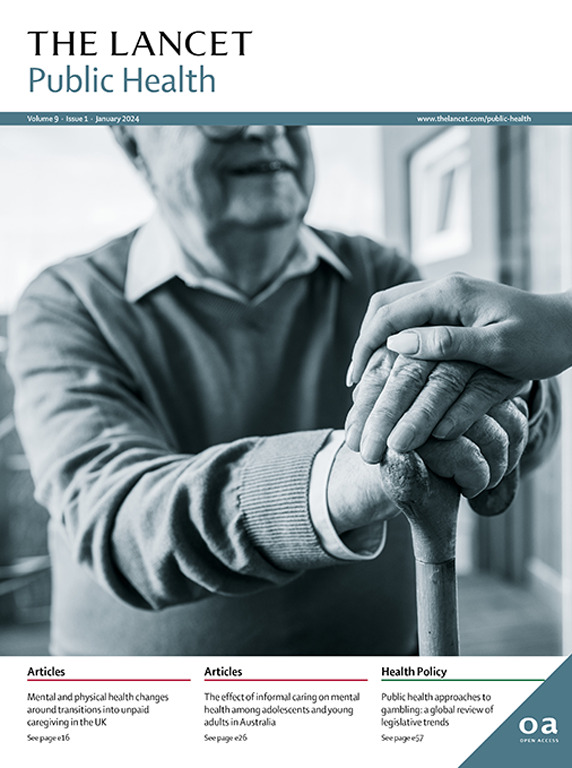Demographic, socioeconomic, and social barriers to use of mobility assistive products: a multistate analysis of the English Longitudinal Study of Ageing
IF 25.4
1区 医学
Q1 PUBLIC, ENVIRONMENTAL & OCCUPATIONAL HEALTH
引用次数: 0
Abstract
Background
Cross-sectional evidence suggests that access to essential mobility assistive products (MAPs) might be dependent on non-clinical factors. However, MAP use is better understood as a dynamic process wherein individuals pass through different states of MAP need and use. We aimed to test associations of demographic, socioeconomic, and social factors with transitions between MAP need and use states.Methods
For this multistate modelling study, data were drawn from 13 years (May, 2006, to July, 2019) of the English Longitudinal Study of Ageing, a prospective cohort study. We included respondents aged 50–89 years who participated in at least two waves of data collection. We used multistate models to examine associations of demographic, socioeconomic, and social factors, including age, sex, education, employment, wealth, marital status, and help with activities of daily living (ADL), with transitions between three main states: no need for MAPs, unmet need for MAPs, and use of MAPs.Findings
We used data collected from 12 080 respondents (6586 women and 5494 men). During follow-up, 5102 (42·2%) of participants had unmet MAP need and 3330 (27·6%) used MAPs. Women were more likely than men to transition from no need to unmet need (hazard ratio [HR] 1·49, 95% CI 1·38–1·60) and less likely to transition from unmet need to use (0·79, 0·72–0·86). We found an increase in risk of transitioning from no need to unmet need for each 1-year increase in age (1·06, 1·06–1·07), for those with low education level (1·34, 1·23–1·45), those with help with ADL (1·32, 1·16–1·49), and who were not employed (1·22, 1·07–1·40) or disabled (3·83, 2·98–4·93). Similarly, we found an increase in risk of transitioning unmet need to use for each 1-year increase in age (1·06, 1·05–1·06), for those with low education level (1·20, 1·10–1·31), and those with help with ADL (1·25, 1·13–1·38). Increasing wealth was associated with a reduced risk of transitioning from no need to unmet need (0·78, 0·74–0·81) and from unmet need to use (0·94, 0·89–0·99). Single people were more likely to transition from unmet need to use than partnered people (HR 1·21, 95% CI 1·10–1·33).Interpretation
Women might be disproportionately likely to have unmet MAP needs, whereas other demographic, socioeconomic, and social factors are associated with high MAP need overall. Our findings directly support efforts towards expanding access to assistive products and identifying groups that could particularly benefit. As the first study of its kind to our knowledge, replication with other longitudinal datasets is needed.Funding
UK Aid.人口统计,社会经济和社会障碍使用的行动辅助产品:老龄化的纵向研究的多州分析
横断面证据表明,获得基本行动辅助产品(MAPs)可能取决于非临床因素。然而,MAP的使用最好被理解为一个动态过程,在这个过程中,个体经历了不同的MAP需求和使用状态。我们的目的是测试人口、社会经济和社会因素与MAP需求和使用状态之间转变的关系。方法在这项多状态建模研究中,数据来自英国老龄化纵向研究的13年(2006年5月至2019年7月),这是一项前瞻性队列研究。我们包括年龄在50-89岁之间的受访者,他们至少参与了两波数据收集。我们使用多州模型来研究人口、社会经济和社会因素的关联,包括年龄、性别、教育、就业、财富、婚姻状况和日常生活活动(ADL)的帮助,并在三种主要状态之间进行转换:不需要MAPs、未满足MAPs需求和使用MAPs。我们使用了从12080名受访者(6586名女性和5494名男性)中收集的数据。随访期间,5102名(42.2%)参与者未满足MAP需求,3330名(27.6%)参与者使用MAP。女性比男性更有可能从无需求过渡到未满足需求(风险比[HR] 1.49, 95% CI 1.38 - 1.60),而从未满足需求过渡到使用需求的可能性更低(0.79,0.72 - 0.86)。我们发现,年龄每增加1岁,从无需求过渡到未满足需求的风险增加(1.06,1.06 - 1.07),低教育水平(1.34,1.23 - 1.45),帮助ADL(1.32, 1.16 - 1.49),无业(1.22,1.07 - 1.40)或残疾(3.83,2.98 - 4.93)的人。同样,我们发现年龄每增加1岁,过渡需求未满足的风险增加(1.06,1.05 - 1·06),教育水平低的人(1.20,1.10 - 1.31)和ADL帮助者(1.25,1.13 - 1.38)。财富的增加与从无需求到未满足需求(0.78,0.74 - 0.81)和从未满足需求到使用需求(0.94,0.89 - 0.99)过渡的风险降低有关。单身人士比有伴侣的人更容易从未满足的需求过渡到使用需求(HR 1.21, 95% CI 1.10 - 1.33)。妇女可能不成比例地有未满足MAP需求的可能性,而其他人口统计学、社会经济和社会因素与总体上的高MAP需求有关。我们的研究结果直接支持了扩大获得辅助产品和确定可能特别受益的群体的努力。据我们所知,这是同类研究的第一次,需要与其他纵向数据集进行复制。FundingUK援助。
本文章由计算机程序翻译,如有差异,请以英文原文为准。
求助全文
约1分钟内获得全文
求助全文
来源期刊

Lancet Public Health
Medicine-Public Health, Environmental and Occupational Health
CiteScore
55.60
自引率
0.80%
发文量
305
审稿时长
8 weeks
期刊介绍:
The Lancet Public Health is committed to tackling the most pressing issues across all aspects of public health. We have a strong commitment to using science to improve health equity and social justice. In line with the values and vision of The Lancet, we take a broad and inclusive approach to public health and are interested in interdisciplinary research.
We publish a range of content types that can advance public health policies and outcomes. These include Articles, Review, Comment, and Correspondence. Learn more about the types of papers we publish.
 求助内容:
求助内容: 应助结果提醒方式:
应助结果提醒方式:


